Much has been said about India's blossoming economy, the record size of its under-30 population and its high-tech power. What, however, does this mean for the electronic security sector?
Much has been said about Indiaˇs blossoming economy, the record size of its under-30 population and its high-tech power. What, however, does this mean for the electronic security sector?
The market for electronic security equipment in India is estimated at more than US$500 million; this is growing at about 30 percent per year, said the CMP Information Group. There is massive investment taking place in Indiaˇs infrastructure as the country prepares to host the Commonwealth Games in 2010. ¨At a conservative estimate, it is growing at a rate of 25 percent per annum,〃 said Ian Meadows, Business Development Manager, Cardax Systems; others, like Shaji N.M., CEO of Prisma Bytes, put growth as high as 40 percent for the next five years.
Urbanization, economic development and regulatory changes have created an approximately $1 billion fire alarm and security industry in India, said Nikhil Pathak, Country Leader India, UTC Fire & Security Asia. His company has operations in India through Kidde India and Chubb Alba.
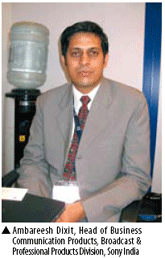
The electronic security market in India is estimated to be in the region of $231 million, said Dhiraj Wali, Vice President of Operations, Bosch Security Systems India; it is growing at a compound annual growth rate of 8.9 percent. Waliˇs figure closely corresponds to that of Frost & Sullivan, which put the figure at $227.3 million.
The president of Indiaˇs only private security industry association, the Asian Professional Security Association (APSA) India Chapter, Iqbal Jagdeva, added that the Indian industry needs definite standards, which the association is helping set with guidelines and assistance from security associations outside India. He echoed many Indian playersˇ sentiments when stating that standards are important to focus the industry on quality.
Drivers and Challenges
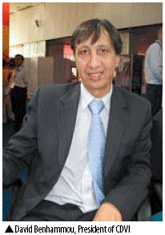
India has a number of conflicts, said Ajay Gupta, Managing Director of Group 4 Security Systems India. The Punjab region was the center of civil unrest; the Kashmir region is still disputed; the Maoist Naxalite extremists are active in eastern, central and southern India; and numerous terrorist attacks have taken place over the past few years.
¨India is traditionally socialist,〃 said Ashok Singh, Managing Director and Chief Operating Officer, Facility Security Division, AutoCop. ¨As such, there are a number of organized groups, especially in eastern India, where powerful local authorities and some semi self-ruled states feel threatened by and wish to see the demise of the increasing dominance of
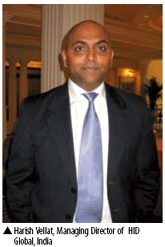
multinationals. Threats feel ever-present to these newly opened corporate offices.〃
The Mumbai train blasts in 2006, increasing fire accidents and violent crime murder, abduction and kidnapping create high awareness especially with respect to safety and security needs, said S. Mushtaq Khan, Industry Manager, Environment & Building Technologies Practice, South Asia & Middle East, Frost & Sullivan. The shift toward globalization leaves India with no option but to meet global standards for safety and security.
¨Before, high tariffs meant that only companies with deep pockets could afford electronic security,〃 Meadows explained.
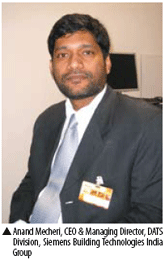
¨Over the years, tariffs have been slowly reduced, making systems more affordable and attractive to a wider range of customers. That said, tariffs are still very high compared with other countries in the region.〃
¨Moreover, recent deregulation and privatization across the growth industries of telecommunications, manufacturing, IT, retail and infrastructure,〃 explained Wali, ¨and project investment-friendly policies by the government, have prompted rapid growth. India is also capitalizing on its large numbers of well-educated people skilled in the English language to become a major exporter of software services and software workers.〃
Delhi, Mumbai and Bangalore are the regions of choice for new entrants as well as for established players in the market, said Oh Tee Lee, General Manager for South Asia Pacific, Axis Communications. As IT-enabled services are increasingly on the radar of major domestic and foreign retail players, these IT centers are the focus. This, in turn, is spurring growth of organized retail. Regionally, Delhi and the North account for about 25 percent of the market, Mumbai and the West about 25 percent, Chennai and Hyderabad and the South about 40 percent, and Kolkata and the East about 10 percent. New Delhi is the hub of the Indian security distribution network. As the seat of government, it is also where many of the key buyers for public security solutions are based.
Price Sensitivity

The market is very price-sensitive, said Adam Rosenberg, Vice President of Marketing for Magal. Because of privatization, private companies are no longer forced to go with the lowest price, and now have a chance to first look for at solution design, technology and experience.
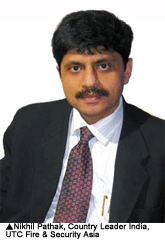
Meadows seconded him: ¨In order to win in this business, vendors had to cut their own costs, which often meant cutting corners with respect to quality of product used and quality of services. Many customers were left high and dry as vendors often went out of business very quickly or when they abandoned particular products due to low margins. These vendors were simply brokers of security components.〃
In recent years, customer awareness of the need to deal with quality system integrators who work with quality products has helped diminish the inclination to accept the cheapest system at the cheapest price. More and more, there is demand for the most competitive price (not necessarily the cheapest).
The British Security Industry Association (BSIA), which recently commissioned a special study on the Indian market, said the picture is a little complicated. ¨First, there is a market for higher value products for installation in foreign-driven investments,〃 said Chris Pinder, Southern Regional General Manager & Export Services Manager of the BSIA. ¨Second, there is lower value product demand in areas such as Indian infrastructure.〃
Vertical Markets
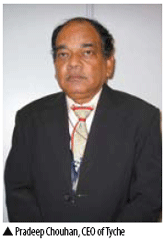
The organized retail boom is expected to spread to Tier-II and Tier-III cities, according to Frost & Sullivan. The hotel industry is expected to invest $82.41 billion during 2007-2012. Sustained economic growth, fiscal consolidation and a policy-driven environment are expected to cause the industrial segment to grow at 9 percent.
Rathin Kumar Banerjee, CEO of Zicom, agreed that the hotel industry is an emerging market, adding that the IT sector, business process outsourcing (BPO), malls, biotech parks and even religious places are emerging verticals for end-to-end security solutions.
¨Infrastructure projects such as new road and
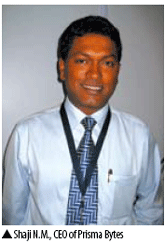
rail networks, highways, and government and commercial buildings lead the way,〃 said Wali. ¨Key in driving growth in the commercial vertical is investment in new commercial complexes in top metropolitan cities. These complexes, especially those of IT corporations, have a defined global standard in terms of security and safety requirements. It is mandatory to strictly adhere to it, and the contract is usually awarded to the local arm of a global service provider. Such projects are also driven by standardized rate and service contracts.〃
In government, investment is being put into state assemblies, parliament houses, defense and R&D labs, and sensitive installation of
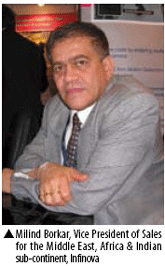
national interest, said Rajesh Solanki, Managing Director of Rasan Infocom. This vertical is very price and performance-conscious; responsible agents usually trust a central agency to coordinate the buying decision process. Projects are always offered to the lowestbidding operator (L1) based on a national-level tendering process. The government of India is by far the single largest buyer of security products and systems and, thus, price sensitivity remains an issue.
Increased security threats generate many enquiries about safety and security systems from the government and defense sectors, but the bureaucratic setup leads to slow clearance of installations across public infrastructure, added the Frost & Sullivan report. Such time lags are also seen increasingly across the corporate and, especially, the commercial sectors. Such factors create problems relating to cash flow management for systems integrators and managing of budgeted costs with the overall effect being reduction in real market growth.
In the public transportation vertical, Wali continued, demand is being fueled by modernization of existing airports and new projects; there are approximately 180 new airport projects in the pipeline. The airports in Delhi and Mumbai have already been awarded big budgets for major modernization and/or renovation, and a new airport is being planned in Mumbai. The Delhi Metro Railˇs existing network of railways is another prospective end user; metro rail networks are presently being set up in major cities.
Retail
As India moves from corner mom-and-pop shops, strip malls and local markets to giant malls, supermarkets, hypermarkets and chain stores, there is an increasing demand for sensors, surveillance cameras and access control, said Yash Kansal, Senior Commercial Specialist, U.S. Commercial Service of the Embassy of the United States of America in New Delhi. ¨Whereas before, Indian retailers relied mainly on manned security, they are now turning to electronic security.〃
According to Lee, the small number of parks and increasing disposable income and corresponding aspirations of the middle class are driving growth in retail, pointing to a trend which vendors at Indiaˇs first IFSEC show also stressed. A McKinsey Global Institute study agreed. Consumption in India is closer, proportionally, to developed countries such as Japan and the U.S. than it is to China, the research company found in a recent study.
Residential
Traditionally, Indian families have led community-model residential lives, explained Kamal Arora, Head of Marketing for South Asia, Honeywell Security. Most Indians have, until recently, lived in a joint-family model; and neighbors knew one another well. This system of support meant that, in emergencies and security breachsituations, the first call of duty was to help oneˇs family member or neighbor. This, along with low disposable incomes, meant that until about a decade ago, need for residential security did not exist.
With urbanization (from 20 percent of the countryˇs population living in cities 10 years ago, to 33 percent today and rising) and the resulting lack of space leading to high-rise buildings, rapidly developing IT-related industries needing young staff, the expanding middle class and its rising income, and the awareness of new technologies following the telephony boom in the 1990s, residential electronic security has come to the fore, Deepak Thakur, Head of Sales for South Asia, Honeywell, expanded, going on to explain the current residential trends.
Residential living in non-rural regions of India and their outskirts can now be divided into four sections: mass housing, luxury flats, villas and townships; and each has different needs and residents lead different lifestyles. It is important for a vendor to be able to understand these distinct requirements of home security and automation and meet all these ends by offering differing solutions to different residential users, especially now that real estate in India is slated to grow at 45 percent per annum and 10 million dwelling units are currently needed. Existing residences are also in need of security, which, at the moment, not many vendors are catering to.
The masshousing category consists of basic, low-income, gated communities with large number of two bedroom-max type apartments, each located in areas with few amenities close by. Luxury apartments cater to the mediumto high-income classes, and are found in gated communities of fewer individual units than mass housing communities. Villas or independent houses are also found in a community, but facilities are luxurious, including swimming pools and gymnasiums. Some villas are owned as a secondary home, for use during vacation periods. Townships are community complexes as well, but so large that they include apartments, villas, hotels, retail outlets, hospitals, and other provisions. These are located in outskirts of metropolitan cities due to space reasons, and can be considered mini towns.
Significant Projects
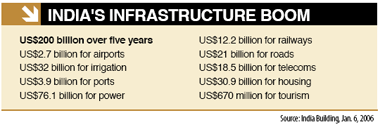
Delhi, a city of 13.8 million spread over 1,500 square kilometers, has installed Indiaˇs first end-to-end IP solution in an initial implementation that meets all demands of the ambitious city surveillance project, revealed Inderjit Sehrawat, Country Manager for India and South Asian Association for Regional Cooperation Countries (SAARC), DVTel. In the initial phase, the Indian Police installed a mix of PTZ and fixed IP cameras in nine locations around the city, added Jagdeva. Key requirements for the system included redundant servers, redundant archiving, and viewing and storage of all video at 4 CIF at 25 frames per second. Another important requirement was ability to generate alarms for a number of preconfigured events, including illegal lane changes, red-light violations, illegal parking and other traffic events.
In a major project, the National Highways Authority of India has been mandated to implement the $13.2 billion National Highway Development Project (NHDP), which includes the Golden Quadrilateral (GQ) and NS-EW (NSEW) corridors. The GQ is the largest express highway project in India and consists of building 5,846 kilometers of four and six-lane express highways connecting Delhi, Mumbai, Kolkata and Chennai (thus forming a quadrilateral), at a cost of over $12.3 billion. The NSEW corridor consists of building 7,300 kilometers to link Srinagar, Kanyakumari, Porbandar and Silchar.
A new contract was announced for an innovative fiberoptic transmission system for traffic management and control of five new toll roads, said Alan Hayes, founder and Managing Director of AMG Systems. The projects called for a dual-redundant system for real-time uncompressed video transmission and ability to cope with multiple add-on modules via Ethernet. ¨The construction plans for new roads as well as increased traffic density especially around major cities makes India a prime market for fiberoptic uncompressed digital CCTV transmission solutions for traffic management.〃
〗Related Report
India: Product Sector Overview
Security Concepts Taking Root in India